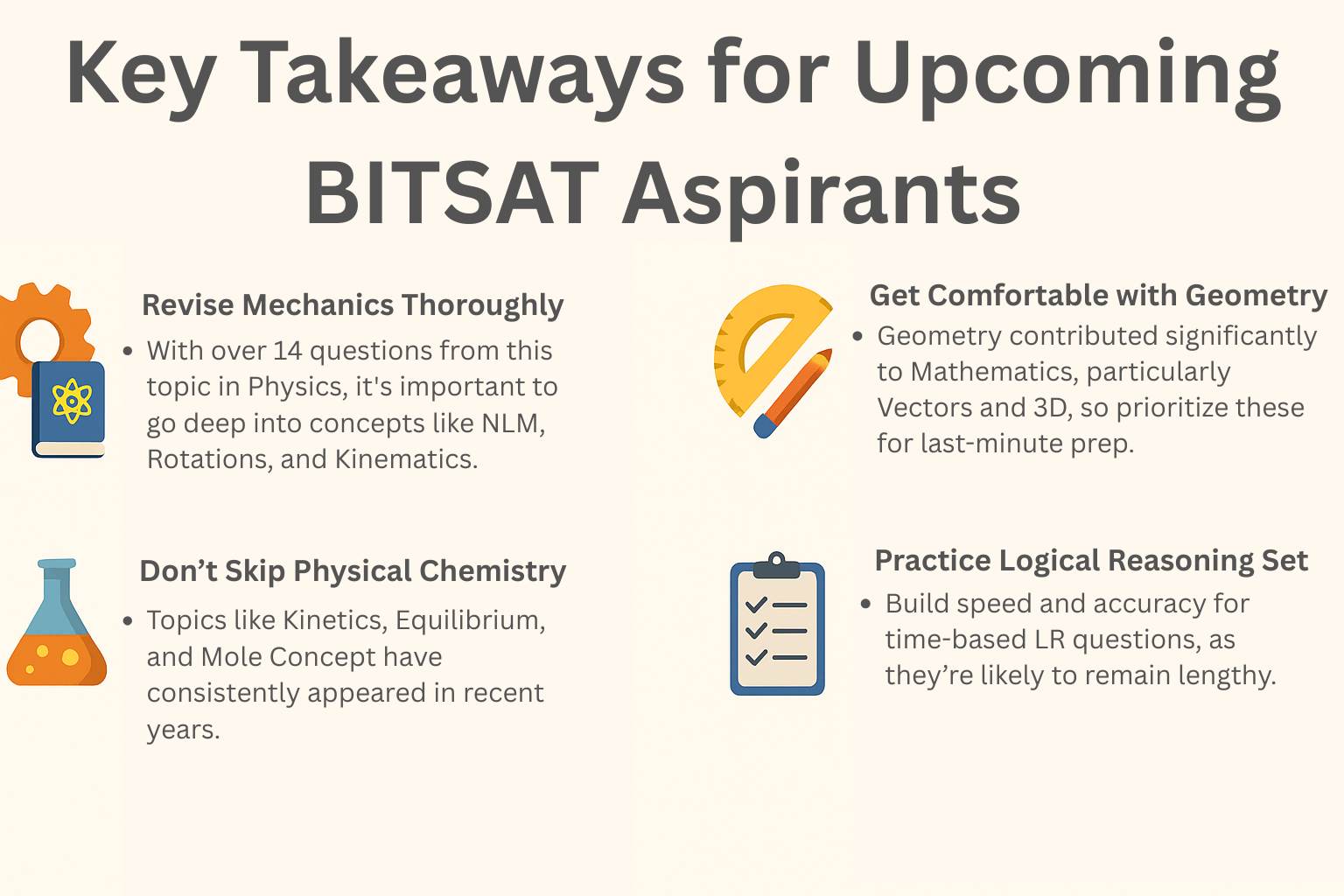Table of Contents
[Exam Review] BITSAT 2025 Shift 1 (23 June Morning) – Question Paper Analysis & Student Reactions
Pratham Jiwnani
6/23/2025
![[Exam Review] BITSAT 2025 Shift 1 (23 June Morning) – Question Paper Analysis & Student Reactions](https://cdn.sanity.io/images/p3j1jh9k/production/f92acf0fde208c1fec3f5d6804677325d5bea282-1024x1024.jpg)
The first morning shift of BITSAT 2025, held on June 23rd, left students with plenty to talk about. From a challenging Physics section to Geometry reigning supreme in Math, responses to the paper were a mixed bag. While some found the paper manageable, others mentioned difficulties with Logical Reasoning and Chemistry.
If you’re preparing for upcoming BITSAT shifts or curious about this year’s trends, this detailed breakdown of Shift 1 will help you understand what went down and how to prepare better.
BITSAT 2025 Shift 1 (23 June Morning) Morning Shift Overview
The BITSAT 2025 morning paper was lengthy, diverse, and challenging in parts. While students admitted that many questions came from expected topics, there were also surprises in terms of complexity and question distribution.
Overall, Logical Reasoning stood out as time-consuming, Physics leaned heavily on Mechanics, and Chemistry required an in-depth understanding of concepts. On the other hand, Mathematics, though moderate, had a higher focus on Geometry and Coordinate topics.
Here’s a subject-wise breakdown based on verified student feedback and analysis.
Subject-Wise Analysis
Mathematics – Moderate, Geometry & 3D Heavy
The Mathematics section for Shift 1 leaned heavily on Geometry, Coordinate Geometry, and Vectors, making it a mixed experience for students. Surprisingly, there were no Definite Integration questions, which had been a common topic in earlier years.
Key Topics Asked:
- Vectors & 3D Geometry: Dominated with a focus on planes and normals.
- Trigonometry: 2–3 questions ranging from basic identities to advanced equations.
- Indefinite Integrals: Around 3 questions were asked.
- Linear Programming Problems (LPP): 1 question.
- Probability & Statistics combined contributed approximately 3–4 questions overall.
- Definite Integration: Completely absent this time.
“Almost 25 questions were from Geometry, Coordinate, Vector 3D, and triangle topics. If you've practiced these thoroughly, it wasn’t too bad.” – Student 1
Physics – Mechanics Dominant, Formula-Heavy
Physics proved to be tricky, with a significant portion dedicated to Mechanics (14+ questions). While the paper featured both theoretical and numerical problems, some questions required obscure formulas that added to the difficulty.
Key Topics Asked:
- Mechanics: Covered topics like Newton's Laws of Motion (NLM), Rotation, and Kinematics.
- Ray Optics: Just 1 question, but straightforward for those familiar with the basics.
- Modern Physics: Topics included the KE of ejected electrons and nuclear physics concepts.
- Heat, Capacitors & Current: Represented with 1–2 questions each.
- Brewster’s Angle: 1 direct question.
- Semiconductors: Primarily theory-heavy.
- Electrostatics: One geometry-based problem involving charges and cones.
“Physics wasn’t just tough; it was tricky and required lots of formulas. Mechanics alone had so many questions.” – Student 2
Chemistry – Moderate-Hard, Conceptually Diverse
Chemistry stood out as a moderate to hard section. Students found it a blend of Physical Chemistry, Organic Chemistry, and a few tricky conceptual questions from Inorganic Chemistry.
Key Topics Asked:
- Kinetics & Equilibrium: Kp-based and cell reaction-related questions were prominent.
- Solid State Chemistry: Around 3 questions, including conceptual examples.
- Electrochemistry: 2 calculation-based queries.
- Oxo Acids & Acid Strength: Conceptual strength-based questions.
- Organic Chemistry: Tests like Sooty Flame and Brisk Effervescence Identification.
- Conformations: A dihedral angle in the gauche conformation was tested.
- Sulphide Salts & Nucleophilicity: Questions on properties and orders were included.
“Physical Chemistry topics like Kinetics and Mole Concept were expected but tricky. Organic threw some curveballs too.” – Student 3
English & Logical Reasoning
English Section Highlights:
- Mixed responses were seen for this section. For some, it was a cakewalk with full scores, while others found the vocabulary and comprehension slightly tougher than expected.
“English was surprisingly easy. I scored 30/30!” – Student 1
Logical Reasoning:
- Universally acknowledged as tough and time-consuming, Logical Reasoning featured analytical sets that required significant focus.
“Logical Reasoning just drained so much of my time. It wasn’t even about being difficult, it just felt long.” – Student 2
Key Takeaways for Upcoming BITSAT Aspirants

Based on the insights from students and the trends of the 23 June morning shift, here are some actionable tips for those yet to appear for their BITSAT 2025 exam:
- Revise Mechanics Thoroughly: With over 14 questions from this topic in Physics, it's important to go deep into concepts like NLM, Rotations, and Kinematics.
- Get Comfortable with Geometry: Geometry contributed significantly to Mathematics, particularly Vectors and 3D, so prioritize these for last-minute prep.
- Don’t Skip Physical Chemistry: Topics like Kinetics, Equilibrium, and Mole Concept have consistently appeared in recent years.
- Practice Logical Reasoning Sets: Build speed and accuracy for time-based LR questions, as they’re likely to remain lengthy.
- Prepare for Variety: Questions were scattered across all topics, so don’t pigeonhole your focus into "high-weightage" topics alone.
Final Words
The BITSAT 2025 morning session was a mixed bag, offering both predictable and unexpected challenges across all sections. However, the feedback heavily leans towards the importance of time management and thorough revision of foundational concepts.
Preparing for future shifts? Stay tuned for subject-wise revision guides, memory-based questions, and expected cutoffs on our blog.